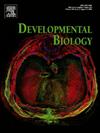The transcription factor Capicua maintains the oocyte polarity in the panoistic ovary of the German cockroach
IF 2.5
3区 生物学
Q2 DEVELOPMENTAL BIOLOGY
引用次数: 0
Abstract
The establishment of the symmetry axis is crucial for the development of all organisms. In insects, this process begins early in oogenesis with the correct distribution of the mRNAs and proteins in the oocyte. One protein that plays a role in organizing this distribution is the transcription factor Capicua (Cic). Cic has been studied in the context of oogenesis and embryonic development in Drosophila melanogaster. It is maternally expressed, begins essential for establishing the dorsoventral axis, and functions as a transcriptional repressor. Although the Cic sequences are conserved across species, their function in other types of insect ovaries is still little known. We wondered whether the function of Cic in insects has been maintained through evolution despite the ovary type or if it has been modified in parallel to the ovary evolution. To address this, we studied the Cic function in a phylogenetically basal insect, the cockroach Blattella germanica, a species with panoistic ovaries. Our findings show that B. germanica Cic is essential for oocyte development and the maturation of ovarian follicles. A loss of Cic function leads to disrupted cytoskeletal organization, defects in anterior-posterior polarity, and compromised follicle integrity. The conservation and functional divergence of Cic across different species suggest evolutionary adaptations in the mechanisms of insect oogenesis.

求助全文
约1分钟内获得全文
求助全文
来源期刊

Developmental biology
生物-发育生物学
CiteScore
5.30
自引率
3.70%
发文量
182
审稿时长
1.5 months
期刊介绍:
Developmental Biology (DB) publishes original research on mechanisms of development, differentiation, and growth in animals and plants at the molecular, cellular, genetic and evolutionary levels. Areas of particular emphasis include transcriptional control mechanisms, embryonic patterning, cell-cell interactions, growth factors and signal transduction, and regulatory hierarchies in developing plants and animals.
 求助内容:
求助内容: 应助结果提醒方式:
应助结果提醒方式:


